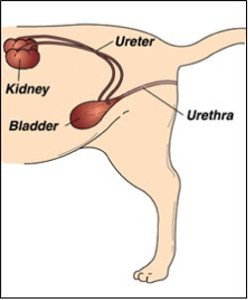Are you facing a situation where your CAT has deserted its litter box and is urinating around different spots in your home? Your cat needs help! It isn’t trying to be disobedient. The problem of inappropriate urination could stem from some grave underlying causes that could include a behavioural problem or a medical condition termed as feline lower urinary tract disease (FLUTD).
There are clear signs that indicate the unfortunate occurrence of a urinary tract disease. Let us study the symptoms that will help cat owners expedite the treatment process.
- Difficulty in urinating and making a great effort in trying to do so: This occurs due to bladder inflammation and is called feline idiopathic cystitis. The cat will be seen forcing and straining to urinate. This lower urinary tract disease often takes a more harsh turn thus forming stones in the bladder or the urethral plug. Urethral plug is when the cat is unable to urinate all together. Male cats suffer a bigger risk of developing this fatal illness where they lose the ability to pass urine.
-
Great pain and discomfort while urinating: The poor cat may possibly experience so much pain while urinating that it could make her literally cry. Cats who suffer from urinary tract disease are seen licking their genital region to reduce the pain. The pet may also lick the area around the abdomen in an attempt to lessen the ache. Felines suffering from said disease become more peevish than usual.
- The frequent urge to pass urine: The pet feels the urge to urinate again and again as only a small quantity is expelled each time. In case of a urethral plug the cat loses its ability to pass out urine altogether, this means that the animal will not be able to eject waste materials that build up in the body through the process of urination.
- The urine will be stained with blood: This is another sign of FLUTD. Female cats experience the problem of discolored urine more than the males.
- No longer using the Cat litter box: Your pet cat will ditch its litter box for other spots, and perhaps will choose a cool surface such as tile flooring.
The presence of one or more symptoms must transpire into a visit to the vet:
The diagnosis will include collection of urine samples, X-rays and an ultrasound of the abdominal area. The objective is to reach to the root cause of lower urinary tract disease. While addressing certain cases the vet will carry out blood tests as well.
It has been observed that some FLUTD cases healed naturally with time without the need for medical intervention. However the symptoms not only induce pain and discomfort to the pet but may also come back again in future. It is best to involve the vet and get the problem treated using medical and professional help to relieve the cat and improve the quality of its life. If a large number of stones are found in the cat a surgery is recommended to remove them.
In order to prevent the occurrence of lower urinary tract disease in future the cat parent must ensure a positive environment for the pet supplemented by spending quality time with the feline and providing suitable cat toys for mental & physical stimulation. If the cat spends most of its time indoors, the presence of large windows in the rooms will help it to connect to the outdoors. Experts too believe that stress can trigger the urinary tract disease symptoms. Apart from this, it is always a good idea to provide the kitty with a diet rich in wet/canned cat food and increase its water intake. By increasing the water consumption along with a wetter diet work towards a healthy bladder and diluted urine. All of these steps will definitely prevent future outbreaks. The cat owner can always add some more litter boxes to the existing number and place in different corners of the house.

